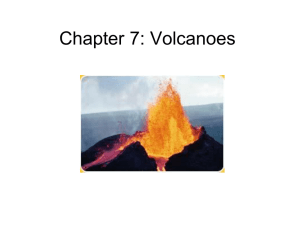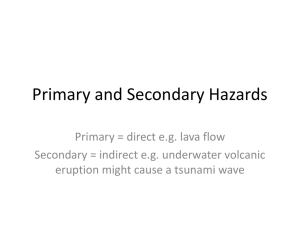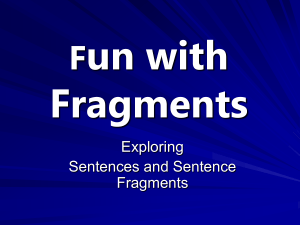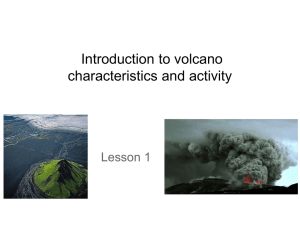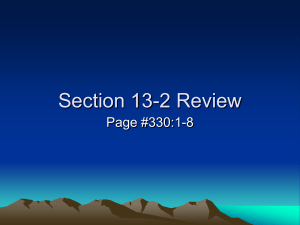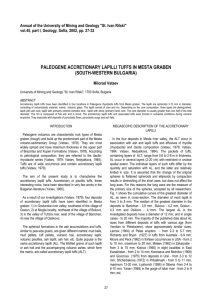Pyroclastic rocks
advertisement
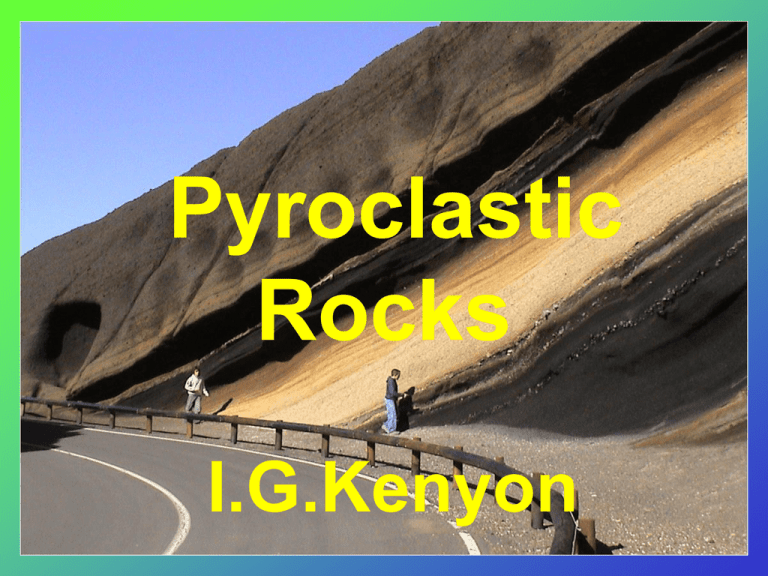
Pyroclastic Rocks I.G.Kenyon Pyroclastic Rocks Consist of fragmental volcanic material blown into the atmosphere by explosive activity Mainly associated with felsic volcanoes Pyroclastic Rocks – 2 Main Groups Material ejected from the volcano as liquid globules which solidifies in the air and is deposited as solid particles Material ejected from the volcano as solid fragments, this solid material has been fractured by the explosive activity Materials Ejected in a Liquid State Pelées Hair Volcanic Bombs Pumice Scoriae Pelées Hair A fine mass of hair-like glass Formed by lava being exuded through a small orifice and blown about by the wind Resembles candy floss in appearance 1cm Volcanic Bombs Larger masses of liquid lava thrown into the air They rotate and take on characteristic shapes Spindle-bombs and breadcrust bombs are most common-usually vesicular Vary in size from small droplets to several cubic metres Volcanic Bombs Some bombs have a characteristic breadcrust surface, others resemble cauliflowers or cowpats depending on the way they land and solidify. Bombs develop a rounded or almond shape as they are twirled through the air. Volcanic bombs are large fragments of molten lava up to 1m in diameter expelled during an eruption. Section through a Volcanic Bomb Highly vesicular interior 5cm Breadcrust exterior, finer grained and less vesicular due to more rapid cooling Pumice Highly vesicular material derived from acid lavas Very high porosity and low density So light that it may float on water Pumice Specimen from Mt. Teide, Tenerife Mineralogy: quartz, feldspar and mica Volcanic, felsic igneous rock Low density, high porosity, floats on water Vesicles up to 3cm in diameter Microscopic grain size, very rapid cooling at the earth’s surface 2cm Scoriae Associated with mafic lavas Vesicular but denser than pumice Globules of lava are ejected and the exterior chills and solidifies Interior is still hot and molten Upon landing they are still soft and are flattened into pancake shapes Section through Strombolian Scoriae Cone Bedding dips 32°SE The cone has been half excavated for use in the construction industry Some layers rich in volcanic bombs 2m Strombolian refers to the style of pyroclastic eruption in which fragments of incandescent, vesiculating basaltic magma are ejected to a moderate height, landing as solid scoria to form a cone Strombolian Scoriae Cone Volcanic bombs occur up to 50cm in diameter The structure is very friable and has an unstable surface Scoriae clasts range in size from 3 to 15cm Material Ejected in a Solid State Agglomerate-fragments >64mm in diameter Lapilli – fragments 64mm - 2mm in diameter Ash, Tuff & Dust – fragments <2mm in diameter Agglomerate – Volcanic Breccia Derived from agglomero meaning ‘gather into a heap’ Formed of volcanic or country rock in the vent or as part of the cone Produced by explosive activity which often shatters the top of the cone Coarse material is ejected a relatively short distance before settling back to earth Comprises angular fragments >64mm surrounded by finer tuff and lapilli Agglomerate – Volcanic Breccia 5cm Large angular fragments up to 10cm in diameter Vent Agglomerate Large fragments surrounded by material of ash and lapilli size Agglomerate–Volcanic Breccia, Arico, Tenerife Chaotic mixture of boulders over 2m to ash <2mm in diameter Lapilli – Particles 2 – 64mm Derived from lapillus meaning ‘a little stone’ Most commonly small pea to walnut sized Tuff – Particles <2mm The lithified equivalent of volcanic ash Classified according to the nature of the pyroclastic fragments Crystal Tuffs – composed of mainly crystals Lithic Tuffs – composed of fragments of rock Vitric Tuffs – composed of glassy fragments Welded Tuffs (Ignimbrites) – hot fragments welded together in Nuées Ardentes eruptions The Formation of Ignimbrites Associated with Pyroclastic Flows Nueés Ardentes style eruptions Glowing fireclouds 300-1000°C Particles weld together on settling Activity on Augustine, Alaska, photograph by M.Krafft The Chimiche Ignimbrite, Arico, Tenerife It is unwelded as the particles were cool by the time they had fallen 10-15km through the atmosphere back to earth 15m This deposit covers more than 150 km2 of the ChimicheArico part of the island. It is thought to represent the collapse of a 10-15 km high plinian eruptive column Volcanic Ash – Unconsolidated material <2mm in diameter Road cutting in the Guimar Valley, Tenerife The End
